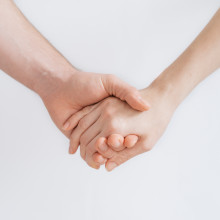Do we all have the same skin sensitivity?
Matt got in touch with this question: "Do all humans have the same number of nerve endings in their skin, and if so, do those of us who are bigger, either taller or fatter, have reduced sensitivity in a given area of skin?" Eva Higginbotham spoke with Professor Francis McGlone from Liverpool John Moores University to feel out the answer...
In this episode

00:00 - QotW: Do we all have the same skin sensitivity?
QotW: Do we all have the same skin sensitivity?
Eva Higginbotham felt out the answer to this question from Matt...
Do all humans have the same number of nerve endings in their skin, and if so, do those of us who are bigger, either taller or fatter, have reduced sensitivity in a given area of skin?
Eva - Ooh, something of a touchy subject there! Our skin has lots of different types of specialised sensory nerves that let the brain know what’s going on anywhere on our bodies. But how does that translate to actually feeling something? I put the question to Professor Francis McGlone of Liverpool John Moores University, he’s an expert in all things touchy-feely.
Francis - We can feel the sense of touch because of sensory nerves that have mechanoreceptors on them, which respond to the physical stimulus of touching something or being touched. We have more densely packed mechanoreceptors in the fingers and lips, and less on the torso or limbs. This can be visualised with Penfield’s famous homunculus - which is a model of a human body where body parts are different sizes depending on how much of the brain is devoted to ‘sensing’ that body part - the hands, lips, and tongue are very large in comparison to the arms, legs, and torso.
Eva - Evan_au on our forum had also heard of the homunculus - though that’s a new word for me! So it’s thanks to mechanoreceptors in our skin that we can feel the sensation of touch, and the number of those nerves you have going to a certain body is called the ‘innervation density’ of that body part. But how does this relate to size?
Francis - If you have naturally bigger lips or fingers, then the innervation density will scale up to fill the available space. But tactile acuity, which is your ability to detect a specific physical stimulus such as a gentle touch, will remain the same – so size shouldn’t matter.
Eva - So human to human, big or small, we should all have about the same sensitivity in the same body parts. But what happens if you get bigger, like through gaining muscle or pregnancy? Would you still have the same level of tactile acuity as before you expanded? Well, Francis says we don’t actually know - yet!
Francis - One way this could be tested in the lab by measuring the sensitivity of a pregnant woman’s stomach in early vs late pregnancy. Altogether, all humans have about the same number of nerve endings in the skin, although they are more concentrated in certain parts of the body than others, though whether overall sensitivity changes with body size, this remains to be seen.
Eva - So still somewhat of an unknown - I smell a recruitment-drive for a study coming on! Next time, we’ll be going with the flow to find the answer to this question from Rakesh
Rakesh - So typically when electrons flow for the electric current, do they come out from the atoms and flow as electric current? Is it not true that when electrons come out from atoms, light and energy is released? So why don’t electric wires change their colours?










Comments
Add a comment